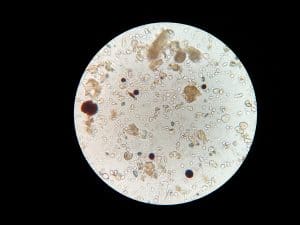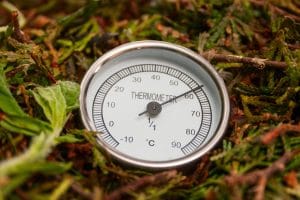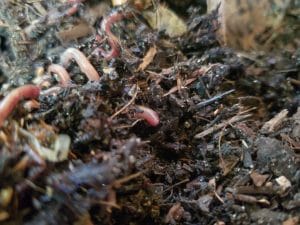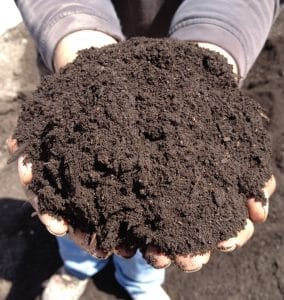Do I have to turn my compost? Should I turn my compost?
We’re going to lay out the reasons why you would or would not turn your compost. It’s as simple as personal preference but first there’s some things you need to know. Learn a little about how compost works, then you can decide whether or not you’ll turn your compost.
Why Would I Need to Turn My Compost?
The main reason for turning compost is to provide aeration.
Compost needs to have oxygen moving freely throughout the pile to aid decomposition. Read on, it’s about to get interesting…
Enter the Microorganisms! The key to understanding compost.
How does decomposition occur? That’s the work of microorganisms. There’s a particular type of microorganism that starts the process. Put some kitchen scraps in your compost pile and cover them with some brown stuff – dead leaves, pine needles, dry plant waste (but not from plants that were infected or diseased or treated with toxic chemicals), or paper. That’s an invitation to a microorganism party.
They’ll come with big appetites and work for a few days to break down the biodegradable matter. This heats things up and the pile can reach 104°. They
can’t take the heat, so when that happens – party over for the first group of microorganisms.
Now we’re in the second phase. In come the thermophilic microorganisms. They love heat! They will work in temps up to but not higher than 160°. These microbes are most active when the internal temperature of the pile is 150°. Their work is helped by the heat, which promotes the breakdown of proteins, fats and complex carbohydrates. The organic stuff is now being down to finer pieces.
It’s also when the pile can really heat up.
Can there be too much heat in the compost pile? What happens then?
- Too much heat will kill the microorganisms that are trying to breakdown the compost
- When the good guys are dead, anaerobic conditions prevail
- When anaerobic conditions prevail, temps drop and decomposition slows down
- Anaerobic microorganisms (anaerobes) produce chemicals that can be harmful to plants
- Anaerobes cause your compost to stink. They release a chemical that smells like rotten eggs. Gross.
So, when do I turn my compost?
Now that you know about these early stages of compost life, what I’m about to say will make sense.
Turning your compost when it’s at or below 130° will help move the hotter parts out and cooler parts in, so the good microbes can continue working. The temperatures between 135°-160° are ideal for decomposition.

Leaving the pile at or above 160° opens it up to become anaerobic.
If you take the temp every day (kids LOVE to do this) and write it on your calendar, you can track your compost’s progress. You may need to turn it every few days or once a week during this phase. It depends a lot on what you’ve thrown into the pile; the balance of greens and browns, whether it’s summer or winter, and the size of your pile.
If you’re going to turn your pile, this is the time. And now you know why.
Here’s a fun thing to do during the active phase:
- Check the pile temperature
- Turn the compost
- Check the temperature (it should’ve gone down)
- Re-check the temperature after 2-3 hours
- The temperature should be right back at the initial level!
How are weed seeds and parasites in compost killed?
There are pesky things in the compost pile that we don’t want to introduce into our gardens. Things like weed seeds, harmful parasites, insects, and pathogens can be hanging out in the pile even at 135°, so it’s important that the pile reaches at least 150° to ensure good riddance to these nasties. The word of caution here is to not get obsessive and start turning your pile every time the thermometer says 135°. Let it get hot, but not past 160°.
My compost pile is looking smaller, what’s happening?
You’ll see the pile reduce as the heat-loving microbes are breaking down everything in their path. If you’ve been watching the temps during this phase and turning the pile accordingly, you’ll have put everything in the pile in their path. At some point, if you stop adding to the pile, they’re done and they leave.
The first microorganisms in this story return as the temperature cools enough to provide them with appropriat e working conditions. They resume breaking down what the heat-lovers left behind. This time though, they’re joined by fungi, roly-polys and worms.
e working conditions. They resume breaking down what the heat-lovers left behind. This time though, they’re joined by fungi, roly-polys and worms.
Don’t expect the pile to look like soil yet. There will still be lots of food in there since only the most readily available nutrients have been processed.
This is the third phase, known as the “cooling phase”. Everything left to be broken down will be broken down in this phase. The size of the pile will be noticeably smaller. But the compost isn’t ready yet.
When is my compost ready?

In order to ensure your compost is safe and won’t introduce any nasties to your soil or plants, it must rest for a while. This is the final stage, the curing stage. The length of time it takes to move through this whole process is dependent on a lot of factors. This phase is crucial, though, so if you’re in a rush to get some compost, purchase some at your local community garden or garden center. And wait for yours to finish.
Consider your compost finished when it smells earthy and there is nothing left to be broken down. It should smell really good. If you’re turning the pile and that doesn’t cause the temperature to rise, it is done. It should be about 70°.
So, why wouldn’t I turn my compost?
Some gardeners use a “cold composting” method. You layer brown and green and leave it to nature. It takes longer. A lot longer. But if you layer correctly you end up with great compost. The drawback? It can take a year to complete the cold composting process versus maybe six months if you’re turning according to temperatures.
Weigh the length of time to get finished compost (cold composting) against the extra time and effort to monitor temperatures and turn your pile (turning method). What works for you?
How to compost is up to you
I hoped this has helped you understand how compost works and gives you a way to figure out what method will be best for you to use.
The best way to do anything is to do it.
Drop a comment if you have questions and want to learn more about composting. Getting started can be daunting, but doesn’t have to be. We’re here to help!
Happy Composting!
